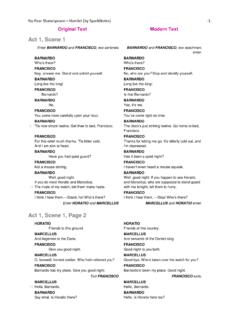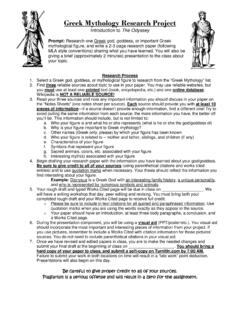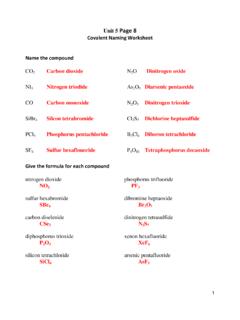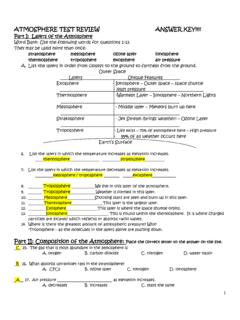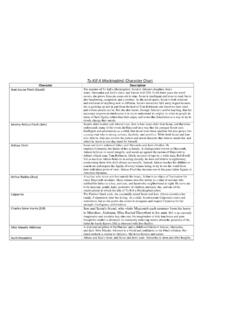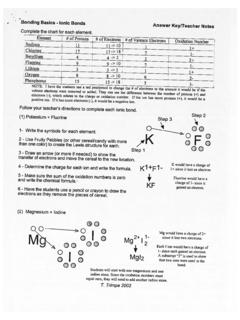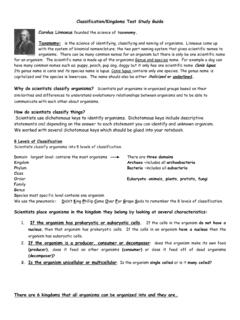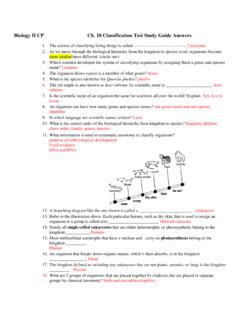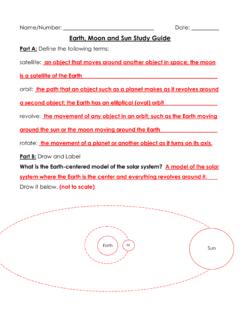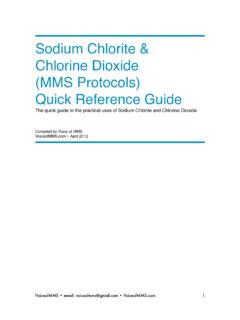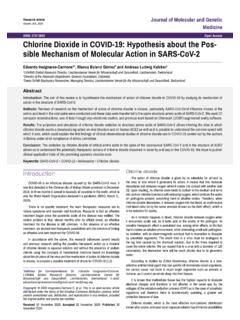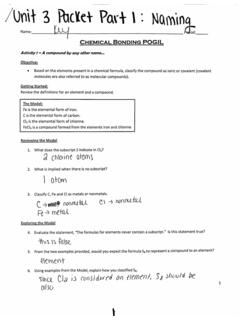Transcription of Unit 9 Chemical Equations and Reactions
1 1 . Unit 9 Chemical Equations and Reactions What is a Chemical Equation? A Chemical Equation is a written representation of the process that occurs in a Chemical reaction. A Chemical equation is written with the Reactants on the left side of an arrow and the Products of the Chemical reaction on the right side of the equation. The head of the arrow typically points toward the right or toward the product side of the equation, although Reactions may indicate equilibrium with the reaction proceeding in both directions simultaneously. The elements in an equation are denoted using their symbols. __Coefficients___ next to the symbols indicate the ____stoichiometric____ numbers. Subscripts are used to indicate the number of atoms of an element present in a Chemical species. An example of a Chemical equation may be seen in the combustion of methane: CH4 + 2 O2 CO2 + 2 H2O Balancing Equations Notes An equation for a Chemical reaction in which the number of atoms for each element in the reaction and the total charge are the same for both the reactants and the products.
2 In other words, the mass and the charge are balanced on both sides of the reaction. Symbol Meaning + used to separate one reactant or product from another used to separate the reactants from the products - it is pronounced "yields" or "produces" when the equation is read used when the reaction can proceed in both directions - this is called an equilibrium arrow and will be used later in the course (g) indicates that the substance is in a gaseous state an alternative way of representing a substance in a gaseous state (s) indicates that the substance is in a solid state an alternative way of representing a substance in a solid state (aq) indicates that the substance is dissolved in water - the aq comes from aqueous (l) Identifies a phase state as pure liquid indicates that heat is applied to make the reaction proceed 2 Use coefficients to make sure the number of atoms is the same on both sides of the equation. 1. _2_ H2 + ___ O2 _2_ H2O 2.
3 _2_ HCl + ___ Zn ___ ZnCl2 + ___ H2 3. _2_ Al + _3_ CaS ___ Al2S3 + _3_ Ca Solid Iron and gaseous chlorine react to produce a solid iron (III) chloride Write the skeleton equation for the reaction Diatomic Elements are always diatomic (written with a subscribe of 2) when they are in their elemental form 1. Hydrogen 5. chlorine 2. Nitrogen 6. Iodine 3. Oxygen 7. Bromine 4. Fluorine 8. Astatine 3 Types of Chemical Reactions Notes Synthesis- two or more elements or compounds combine to form one compound. Decomposition- a single compound decomposes into two or more elements or smaller compounds. Single Replacement- a metal will replace a less active metal in an ionic compound OR a nonmetal will replace a less active nonmetal. Double Replacement- the metals in ionic compounds switch places. Combustion- an organic compound containing carbon, hydrogen and sometimes oxygen reacts with oxygen gas to form carbon dioxide and water.
4 O _____ Synthesis _____: Definition - two or more substances react to form 1 product. Usually releases energy, _ EXOTHERMIC _. Combination Reactions that contain oxygen as a reactant can also be considered combustion. A + X AX 4 Fe (s) + 3 O2 (g) 2 Fe2O3 (s) CaO (s) + H2O (l) Ca(OH)2 (s) One example of a synthesis reaction is the combination of iron and sulfur to form iron (II) sulfide: 8 Fe + S8 ---> 8 FeS o _____ DECOMPOSITION _____: Definition - A single compound breaks down into 2 or more elements or compounds AX A + X 2 NaN3(s) 2Na(s) + 3N2 (g) 2 KClO3 (s) 2 KCl (s) + 3O2 (g) 4 CaCO3 (s) CaO (s) + CO2 (g) **These Reactions often require an energy source as an initiator. Energy sources can be heat, light, or electricity. They are usually _____ ENDOTHERMIC,____. One example of a decomposition reaction is the electrolysis of water to make oxygen and hydrogen gas: 2H2O ---> 2 H2 + O2 o _____ Combustion _____ : Definition - Oxygen gas combines with a substance and releases energy in the form of light or heat.
5 So combustion Reactions are usually exothermic. Combination Reactions that contain oxygen as a reactant can also be considered combustion. A + O2 C(s) + O2(g) CO2(g) + energy 4 Fe (s) + 3O2 (g) 2Fe2O3 (s) + energy For hydrocarbons: CxHy + [x + (y/4)] O2 xCO2 + (y/2)H2O C3H8(g) + O2(g) CO2 (g) + H2O (g) + light + heat o __ Single Replacement _____ : Definition - one ion replaces another in a compound. AB + C --> AC + B One example of a single displacement reaction is when magnesium replaces hydrogen in water to make magnesium hydroxide and hydrogen gas: Mg + 2 H2O ---> Mg(OH)2 + H2 o _____ Double Replacement _____: Definition - two ions replace each other or switch places in compounds. AB + CD --> AC + BD One example of a double displacement reaction is the reaction of lead (II) nitrate with potassium iodide to form lead (II) iodide and potassium nitrate: Pb(NO3)2 + 2 KI ---> PbI2 + 2 KNO3 5 Sample Problems (the solutions are in the next section) List the type of the following Reactions .
6 Solutions 1) NaOH + KNO3 NaNO3 + KOH 2) CH4 + 2 O2 CO2 + 2 H2O 3) 2 Fe + 6 NaBr 2 FeBr3 + 6 Na 4) CaSO4 + Mg(OH)2 Ca(OH)2 + MgSO4 5) NH4OH + HBr H2O + NH4Br 6) Pb + O2 PbO2 7) Na2CO3 Na2O + CO2 1) double replacement 2) combustion 3) single replacement 4) double replacement 5) acid-base 6) synthesis 7) decomposition TYPES OF Chemical Reactions Directions (a) Write and balance the given equation. (b) Indicate the type of Chemical reaction represented. 1. Iron reacts with oxygen gas to produce Iron (III) oxide. (a) 4Fe + 3O2 2Fe2O3 (b) Synthesis 2. Propane (C3H8) reacts with oxygen gas to produce carbon dioxide and water. (a) C3H8 + 5O2 4H2O + 3CO2 (b) Combustion 3. Bromine gas reacts with potassium iodide to produce potassium bromide and iodine gas. (a) Br2 (g) + 2KI 2 KBr + I2 (b) Single displacement 4. Hydrogen peroxide will produce water and oxygen gas if left in sunlight.
7 (a) 2H2O2 2H2O + O2 (b) Decomposition 5. White Phosphorous reacts with oxygen gas to produce tetraphosphorous decoxide. (a) P4 + 5O2 P4O10 (b) Synthesis 6 6. Iron (III) Chloride reacts with sodium hydroxide to produce Iron (III) hydroxide and sodium chloride. (a) FeCl3 +3 NaOH Fe(OH)3 +3 NaCI (b) Double Replacement 7. Iron (III) oxide reacts with hydrogen gas to produce iron and water. (a) Fe2O3 + 3 H2 2 Fe + 3 H2O (b) Single Replacement 8. Octane (C8H18) reacts with oxygen gas to produce carbon dioxide and water. (a) 2 C8H18 + 25 O2 18 H2O + 16 CO2 (b) Combustion 9. Calcium carbonate reacts with aluminum phosphate to produce calcium phosphate and aluminum carbonate. (a) 3 CaCO3 + 2 AlPO4 Ca3(PO4)2 + Al2(CO3)3 (b) Double Replacement 10. Aluminum hydroxide decomposes to produce aluminum oxide and water. (a) 2 Al(OH)3 Al2O3 + 3 H2O (b) Decomposition 11. Zinc reacts with silver nitrate to produce zinc nitrate and silver.
8 (a) Zn + 2 AgNO3 Zn (NO3)2 + 2 Ag (b) Single Replacement 12. Glucose (C6H12O6) reacts with oxygen gas to produce carbon dioxide and water. (a) C6H12O6 + 6 O2 6 CO2 + 6 H2O (b) Combustion 13. Potassium oxide reacts with water to produce potassium hydroxide. (a) K2O + H2O 2 KOH (b) Synthesis 14. Lead (IV) oxide decomposes into lead (II) oxide and oxygen gas. (a) PbO2 Pb + O2 (b) Decomposition 15. Hydrochloric acid (hydrogen chloride) reacts with barium hydroxide to produce water and barium chloride. (a) 2 HCl + Ba(OH)2 2 H2O + BaCl2 (b) Double Replacement 7 Change the coefficients to make the number of atoms of each element equal on both sides of the equation 1. Calcium metal reacts with water to form solid calcium hydroxide and hydrogen gas. Ca + 2H2O Ca(OH)2 (s) + H2 (g) 2. Zinc hydroxide solution reacts with lithium to form lithium hydroxide solution and zinc metal. Z(OH)2 (aq) + 2 Li 2 LiOH (aq) + Zn 3.
9 Liquid propanol (C3H7OH) reacts with oxygen gas to form carbon dioxide gas and water vapor. 2 C3H7OH (l ) + 9 O2 6CO2 (g) + 8 H2O *note that C3H7OH is a Liquid (l ) 4. Aluminum metal reacts with oxygen gas to form solid aluminum oxide. 4 Al + 3 O2 (g) 2 Al2O3 (s) 5. Liquid carbonic acid (hydrogen carbonate) decomposes into carbon dioxide gas and water. H2CO3 CO2 (g) + H2O 6. Lead (II) nitrate solution reacts with iron (III) chloride solution to form solid lead (II) chloride and Iron (III) nitrate solution. 3 Pb(NO3)2 (aq) + 2 FeCl3 (aq) 3 PbCl2 (aq) + 2 Fe(NO3)3 (aq) 7. Aluminum metal reacts with silver sulfate solution to form aluminum sulfate solution and silver metal. 2 Al + 3 Ag SO4 (aq) Al2(SO4)3 (aq) + 3 Ag 8. Methane gas (CH4) reacts with oxygen gas to form carbon dioxide gas and water vapor. CH4 + 2 O2 (g) CO2 (g) + 2 H2O (g) 9. Iron metal reacts with bromine gas to form iron (III) bromide solid.
10 2 Fe + 3 Br2 (g) 2 Fe Br3 10. Hydrogen peroxide solution decomposes into water and oxygen gas. 2 H2O2 (aq) 2 H2O + O2 (g) 8 Balancing Chemical Equations Worksheet Balance the following Chemical Equations using coefficients 1 1Al(OH)3(s) + 3 HCl (aq) 1 AlCl3 (aq) + 3H2O (l) 2. 3Fe2O3 (s) + 1CO (g) 2Fe3O4(s) + 1CO2 (g) 3. 4 FeO (s) + 1O2 (g) 2Fe2O3 (s) 4. 2C6H6 (l) + 15O2 (g) 12CO2 (g) + 6H2O (g) 5. 3Ca(OH)2 (aq) + 2H3PO4 (aq) 6H2O (l) + 1Ca3(PO4)2 (s) 6. 2I4O9 (s) 1I2O6(s) + 3I2 (s) + 6O2 (g) **there s another way to balance this you figure it out?** 7. 2Eu (s) + 6HF (g) 2 EuF3 (s) + 3H2 (g) 8. 3 NaHCO3 (aq) + 1C6H8O7 (aq) 3CO2 (g) + 3H2O (l) + 1Na3C6H5O7 (aq) 9. 1Ni (s) + 4CO (g) 1Ni(CO)4 (g) 10. 1K2 PtCl4 (aq) + 2NH3 (aq) 1Pt(NH3)2Cl2 (s) + 2 KCl (aq) Write the following Chemical Equations and balance using coefficients. 1. Liquid mercury reacts with liquid bromine to produce solid mercury (II) Bromide Hg (l) + Br2 (l) HgBr2 (s) balanced 2.

